Whether you’ve taken advantage of a great sale on bulk bananas or you enjoy preserving food as a homesteading practice, dehydrating bananas is definitely something you should try. Get to enjoy dried banana pieces easily and at a fraction of the price of store-bought dried fruit!
Banana is one of those fruits that can be used in so many recipes. From baking delicious banana bread, banana cream pie or other pastries, to adding as a fruity garnish for pancakes, breakfast smoothie bowls or healthy chia pudding. The options are endless!
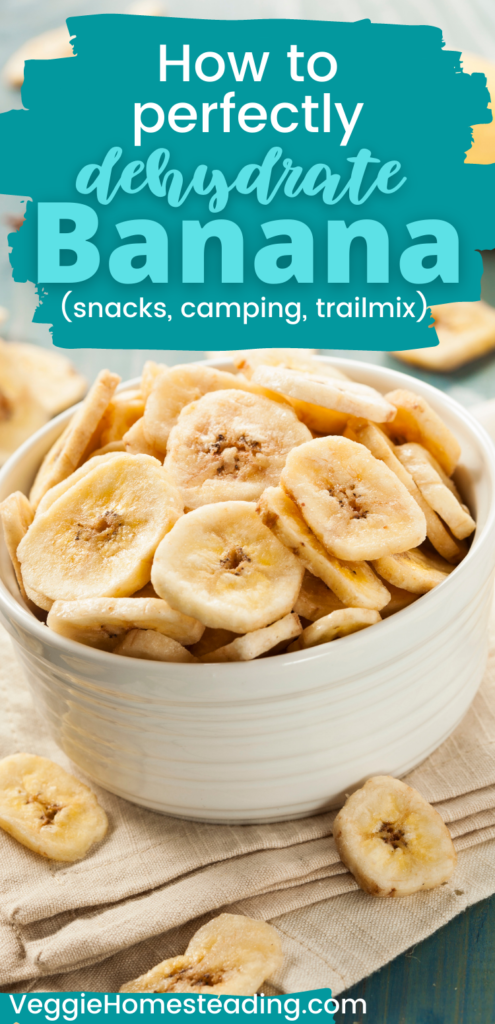
Now, having a ready supply of bananas couldn’t be easier. Simply dry banana chips at home using a food dehydrator to store large batches of dried pieces in your pantry. There’s really no need to rush off to the store every time you need bananas, plus storing your own homemade dried bananas is going to save you so much money in the long run!
If the prospect of drying your own bananas to you seems daunting, let me assure you that it’s anything but that! This article walks you through everything you need to know about dehydrating bananas so you aren’t left in the dark and can feel confident about making your first batch that you will feel proud of.
In this article you’ll find:
- The health benefits of dried bananas
- How to prepare your bananas for dehydration
- Step by step directions for dehydrating bananas in a food dehydrator
- The time it takes to dehydrate bananas
- Alternative methods to dry bananas without a food dehydrator
- How to store dehydrated bananas
- Ways to enjoy dehydrated bananas
- How to rehydrate your dried bananas
In addition to this comprehensive article, I’ve also created the Dehydrating 101: Beginners Guide To Dehydrating as a resource for you to better understand how to start dehydrating foods.
But for now, let’s start with answering all your questions about dehydrating bananas:
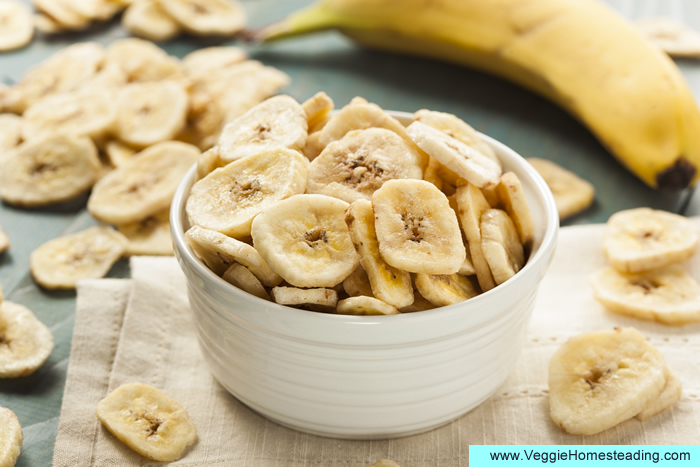
The Health Benefits Of Dried Bananas
Like all dried fruit, dehydrated bananas are just as nutritious for you as fresh bananas except that once dried, they are substantially more nutrient condensed. What this means is that you’ll consume the same amount of nutrients in a small quantity of dried banana chips or pieces (whichever way you decided to slice your fruit) as you would with one whole fresh banana.
For this reason, it’s always advised that you be mindful of how much dried banana you eat in one sitting, especially if you are watching your weight. Bananas, although healthy whole foods, are high in carbohydrates and natural sugar which can contribute to weight gain if consumed in larger portions.
Homemade dried banana is usually always a healthier option than purchasing store-bought banana chips (either standalone or in trail mixes) as commercially produced dehydrated banana contains added sugars and oils that are not needed to sustain a healthy diet.
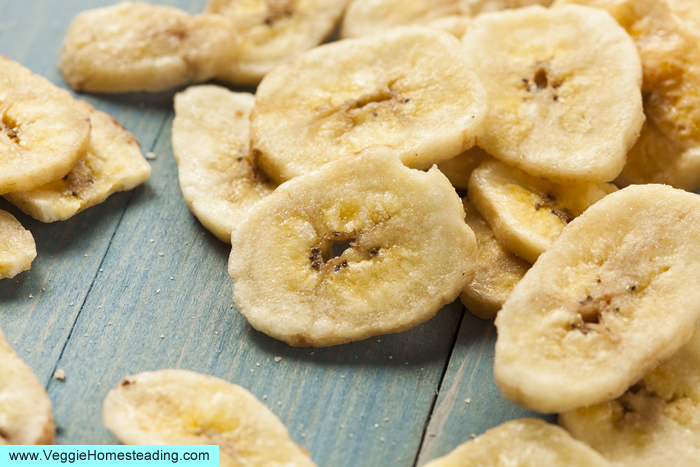
How To Prepare Your Bananas For Dehydration
It’s important to note that whichever way you decide to slice your bananas, the sliced pieces must be around ⅛” thickness so that the pieces can dry adequately and not retain any moisture.
Having peeled your bananas, you can either slice them lengthwise or slice them across into thin chips. The amount of banana pieces you can dry at one time will also depend on the size of the food dehydrator used so before getting carried away and peeling a bunch of bananas, rather start off with 2-3, place them on a tray and assess how many more you can still fit on your trays.
With the slicing out of the way, let’s have a look at a few vital steps that need to take place in preparation for dehydrating your bananas to ensure the best possible result.
Ways To Prepare Bananas For Dehydration
#1. Practice Good Hygiene
It’s worth mentioning from a food safety point of view that your working space and surfaces must be kept hygienic and clean when preparing your bananas for drying. Any bacteria or contaminant that touches your bananas or finds its way into your dehydrator may affect the longevity of your bananas too!
Instead of using harsh chemical cleaning agents, consider making use of eco-friendly, non-toxic cleaning supplies.
#2. Wear Gloves When Handling Your Bananas
Try to avoid touching your bananas with bare hands while slicing and preparing them as our hands contain moisture and oil that can easily be transferred to whatever we touch and you need to be limiting as much moisture from the dehydrating process as possible. A great way to remedy this is to wear latex or vinyl gloves when preparing and handling your dehydrated food.
#3. Preheat Your Dehydrator
As you would preheat an oven, so too you should warm up your dehydrator prior to introducing your banana pieces as good initial airflow in the dehydrator will help to eliminate any possible contaminants as well as get the air moving for equal drying should you be using more than one tray.
#4. Use Stainless Steel Knives
Using a stainless steel knife may help in reducing the chance of your banana slices turning that unappetizing brown color.
#5. Spray Banana Slices With Lemon Juice Before Dehydrating
Spraying your banana pieces helps to retain its yellow color and also adds back a bit of vitamin C which can be lost through the drying process. While some suggest dipping or soaking banana slices in 100% lemon juice, I always recommend spraying instead as the soaking can increase the moisture factor, which is something to minimize throughout the whole dehydration process.
An alternative to lemon juice is pineapple juice since it’s also a good source of vitamin C although the added sugar content found naturally in pineapple can make the banana pieces sticky. I just stick to lemon juice as it does the job.
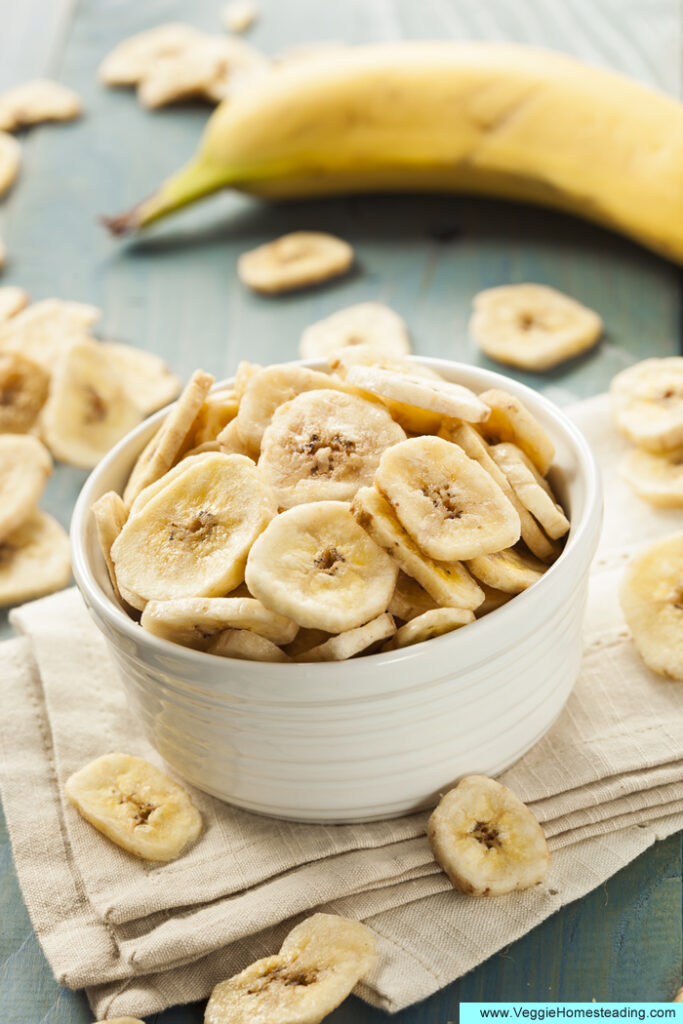
Step By Step Directions For Dehydrating Bananas In A Food Dehydrator
Before you prepare your bananas for drying in the food dehydrator, make sure to buy ripe bananas and avoid those that are still green. Ripe and over ripe bananas have a sweeter taste and if you use over ripe bananas then you’ll end up with deliciously chewy pieces.
With your bananas ready to go, here are step-by-step directions for easily drying bananas in a food dehydrator:
- Prep your workspace and ensure that you are working in a clean environment with clean surfaces, equipment and tools.
- Put on latex or vinyl gloves before you start to work with your bananas.
- Preheat your dehydrator to 135F to allow good airflow through the dehydrator which will eliminate any existing contaminants that may be present.
- Slice your bananas into thin ⅛” pieces and in uniform sizes so that they dehydrate evenly.
- Spray your banana pieces on both sides and edges, evenly coating them with lemon juice from a spray bottle so that you achieve a moderate coverage and don’t waste unnecessarily. You don’t want them soaking in lemon juice.
- Place your banana slices on a tray or trays with equal spacing – overcrowded trays may lead to your bananas requiring a longer dehydration time.
- Place the trays in the preheated dehydrator which is to remain at 135F for 6-8 hours.
- Once the dehydrating time is up, allow your banana slices to sit for 5 – 10 minutes.
- Once cooled, if you are uncertain as to whether your banana slices are dehydrated properly, touch to test for any remaining moisture or place a few in a sealed zip lock bag for a little while to see whether any moisture has been released through condensation. If yes, dehydrate for longer. If not, then store in a vacuumed sealed bag with Mylar bag or in a mason jar to enjoy later as is or in future recipes!
Once your dehydration process is complete, you should be left with banana slices that are dry and leathery. They may be slightly sticky to the touch in some instances and if that is the case, you can follow steps further down in this article to remove any remaining moisture.
The Time It Takes To Dehydrate Bananas
As with anything that you want to dehydrate, it’s essential that you dehydrate it well in order to avoid residual moisture that can cause the food to spoil as a result of bacteria and rot setting in. As a rule, you should rather over dry than under dry.
Aim to get rid of 95% or more of the total moisture in an item of food. Anything less than this will shorten the shelf life of the food and potentially cause it to spoil before you’ve had the chance to enjoy it.
The amount of time it will take to dehydrate banana pieces is approximately between 6-8 hours at a temperature of 135F.
External factors can also play a role in the dehydration time such as:
- The humidity level in your area and house where the dehydration is taking place;
- The thickness of your banana slices;
- Whether you have crowded your dehydrator tray with banana slices or spread them out with room to spare; and
- The type of dehydrator you use and the position of its fan. I’ve already mentioned this in my other articles but to recap – dehydrators with a fan located at the back tend to produce better results than those with a fan fixed at the top or bottom, especially if you have two trays occupying space as the second lower tray will always block flow to the first tray.
And if you ever have the urge to speed up the dehydration process by increasing the heat, try to restrain yourself. It’s far better to allow longer dehydrating times to ensure adequate dehydration than rushing things and ending up with “case hardening” (where your banana is dry on the outside but is still moist on the inside).
If, at the end of your dehydration time, you are not sure whether you’ve reached the 95% stage, make use of one or all of these tests that will help you to detect whether your banana slices have any remaining moisture:
- After 5 – 10 minutes of allowing your banana slices to sit after dehydration, check for any sticky or moist texture. If the banana slices are even slightly sticky or moist then it means that they need a longer time in your dehydrator.
- Touch your banana slices for dryness. You should also be able to tear your banana slice like you would a piece of paper. It should be dry and leathery.
- After allowing your banana pieces to cool once dehydration time is done, place a few in a sealed zip lock bag and return a little later to check for any moisture that would have resulted in condensation. If this has occurred then your banana slices are not adequately dehydrated and require additional time in the dehydrator.
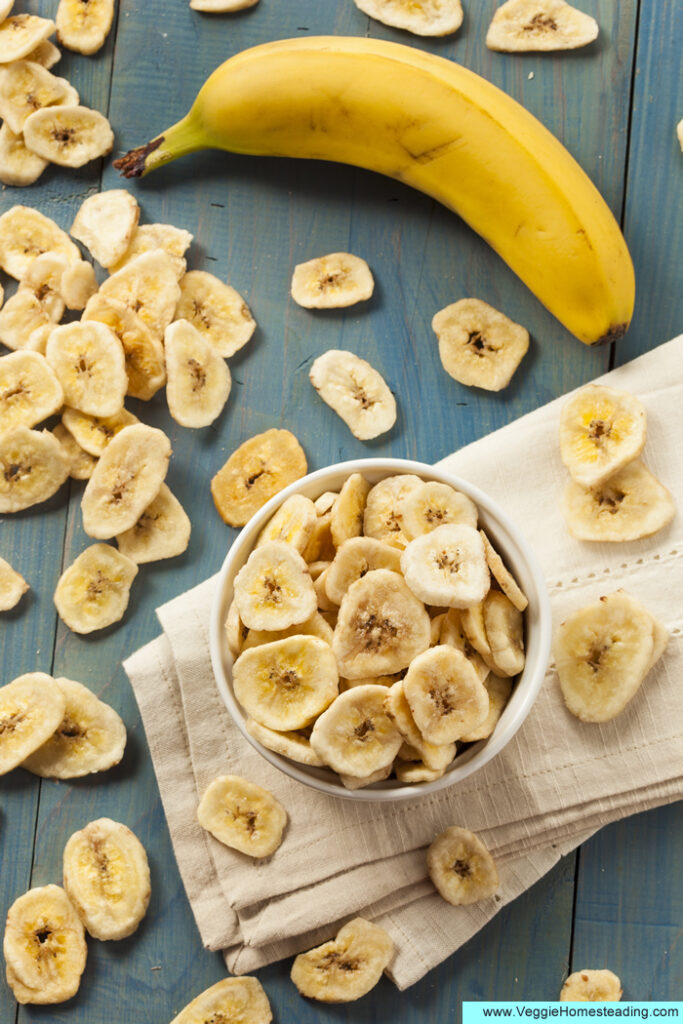
Alternative Methods To Dry Bananas Without A Food Dehydrator
While drying bananas by way of a food dehydrator is what is considered the best method for home dehydration, there are a few other ways in which you could dry your banana slices at home. Here are a few worth considering if you don’t have access to a food dehydrator:
Baking Banana Chips
You can make use of your kitchen oven at home to bake your banana slices. Simply preheat your oven to 175F , place your banana slices on a lined baking tray and bake for 3 hours.
Sun-Dry Bananas
If you have a good amount of space with a good source of sunlight then you can easily sun-dry banana chips and slices using this method.
Unlike the food dehydrator and kitchen oven methods, when sun drying your bananas it’s important to note that you can’t just place your banana pieces in the sun on a tray. There needs to be some form of air circulation from the bottom of the bananas created by adequate space beneath the banana.
Making use of something like this Stackable Cloth Mesh Dry Net is ideal. Once prepping and stacking your banana pieces, allow them to sit in the direct sunlight, turning your banana pieces every two days until all moisture has been removed.
Microwave Drying
Believe it or not but you can also use a microwave to dry out your banana chips and slices. While it won’t give you an end product that will last longer than a few days before going bad, it still is an option should you envisage eating your dried banana soon after drying them in the microwave.
When drying in the microwave, place your banana slices on a well-sprayed tray on the DEFROST setting for 10-15 minutes, turning your banana chips or slices midway.
As with drying your banana slices in a food dehydrator, all previous preparatory steps listed in this article are applicable for when drying bananas in your kitchen oven, microwave or when sun-drying them.
How To Store Dehydrated Bananas
Once you’ve dehydrated your banana slices or chips and are happy that no hidden moisture remains, we then turn to adequate storage.
Dehydrated foods can last anywhere between 3 years to 20 years and beyond if they are properly dehydrated and stored in a cool, dry place!
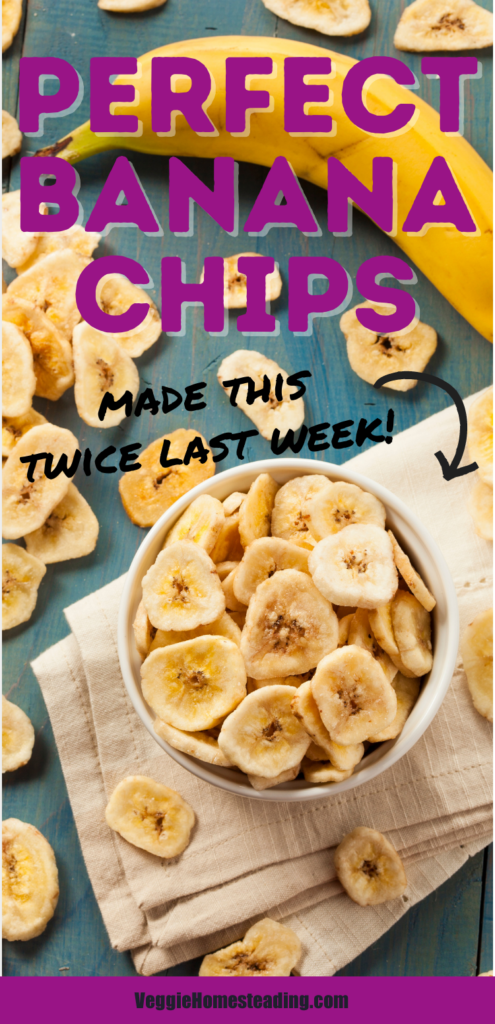
Where To Store Your Dehydrated Bananas
With any dehydrated food, location for storage is vitally important. Your dehydrated bananas need a cool, dry place that is free from potential pests such as rodents and bugs and has a good level of cleanliness.
Since moisture and sunlight are the main culprits for degrading dehydrated foods, it makes sense that the location of storage, as well as the storage containers/bags themselves, need to be as free from these two elements as possible.
Common places to store dehydrated fruit such as bananas include your kitchen, pantry or any other area of your house that is cool, dry and has little sunlight infiltrating the space. This could be your basement or another area I haven’t mentioned. Wherever you decide to store your dehydrated bananas, make sure that they are not sitting close to any household equipment such as dryers or dishwashing machines that emit moisture through condensation.
Supplies And Equipment To Store Dehydrated Bananas
To help your dehydrated banana chips or slices have a long shelf life, it’s best to use the following storage supplies and equipment:
- Sealable vacuum bags using a double-bagging process (for long-term storage);
- Glass jars (typically for shorter-term storage);
- Food grade storage buckets (medium to long-term storage) which I doubt you’ll use for your bananas alone but you could add them sealed in a bag with other dried fruits in the bucket.
Let’s have a look at these 3 main storage supplies and equipment:
Vacuum and Mylar Bags
I would recommend using this kind of storage for your dehydrated banana pieces if you want a long shelf life of a couple of years. It involves vacuum sealing the banana pieces in a vacuum bag together with oxygen absorber sachets and then placing your vacuum bag inside a heat-sealed Mylar bag (known as “double-bagging”).
The vacuum bag with vacuum seal helps to remove any remaining oxygen which is important as oxygen degrades food over time. The double-bagging system using the Mylar bag is to reduce heat and keep out sunlight due to its reflective material.
Glass Jars
Glass Jars like mason jars are also great options for storing dehydrated bananas but will usually offer shorter-term storage owing to the fact that they don’t block out as much light as the double-bagging process above and as already mentioned, the light slowly degrades food over time.
Food Grade Storage Buckets
This option is good when it comes to storing large amounts of a particular dehydrated food so I doubt that you’ll opt for this one although it’s worth mentioning since you may decide to store your dehydrated bananas with other separated and sealed dried fruits or foods.
If you do use this storage method, be sure to only opt for food-grade plastics as ordinary plastic buckets will leak chemicals into the food from the plastics used.
Make sure that the lid on the bucket can be sealed or closed tightly and add oxygen absorbers to your bucket if you’ve stored the food in sealed bags within the bucket. It’s also a good idea to swap out your current bucket for a new one at any sign of deterioration i.e. the lid is not tight anymore or the bucket has already been used for a couple of years.
Having properly dehydrated and stored your banana pieces, you can expect your banana pieces or chips to last for 10-15 years if left sealed and stored. Once you’ve opened the jar or other container then you can expect them to last for 6-12 months.
Remember that storage shelf-life differs depending on how you dried your banana. For instance, if you used the microwave method then you must use up your banana within a couple of days.
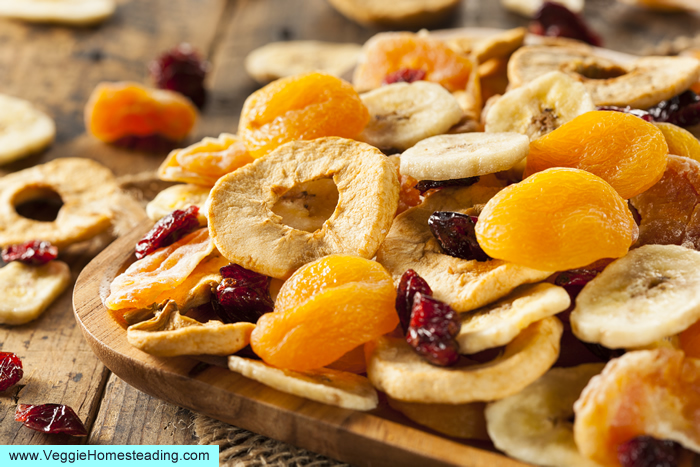
Ways To Enjoy Dehydrated Bananas
There are so many ways that you can enjoy your dehydrated bananas. Here are a few ideas to consider:
- Add them to a breakfast smoothie bowl;
- Include them in baked goods as garnishes or chewy additions to banana bread
- Add them to homemade trail mix that you can take as a snack on your next long road trip or outdoor adventure with the family;
- Stack dehydrated banana slices in a mason jar and decorate the jar with fancy ribbon and a gift tag as a present or house warming gift;
- Rehydrate them and purée them for banana bread or banana cream pie filling.
How To Rehydrate Dried Bananas
To rehydrate your dried banana pieces, simply add them to a bowl and cover them with boiled water or hot juice for 10-15 minutes. You can also soak them in hot rum, brandy, bourbon or a liquor of your choice!
Bottom Line
If you’re “bananas” about bananas then what better way to ensure a constant supply of them than dehydrating your own banana chips and slices for snacks and other homemade treats or meals?
It’s much easier to dry bananas than you may have initially thought and is a wonderfully diverse fruit to start dehydrating with. You can even rehydrate your dried bananas for baked goods whenever needed.
Have you tried dehydrating bananas with success? Let me know how it went – I’d love to hear from you.


Question about the lemon juice in a spray bottle. Is it straight lemon juice or is it water & lemon juice. If the latter how much water, how much lemon juice?. Thank you in advance
It is 100% lemon juice. how much depends on how many bananas you are making. you want to spray to leave a layer on the banana.